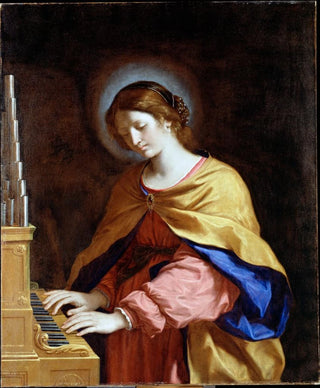Art print | Saint Cecilia - Guercino


View from behind

Frame (optional)
Sainte Cécile - Guercino – Engaging Introduction
The "Sainte Cécile" by Guercino is an iconic artwork that transcends the simple realm of religious painting to become a true ode to music and spirituality. Created in the 17th century, this canvas depicts the patron saint of musicians, surrounded by musical instruments, in a composition rich in emotion and symbolism. This masterpiece not only showcases the artist's technical talent but also his ability to evoke deep feelings in the viewer. The scene, bathed in golden light, creates an almost celestial atmosphere, inviting everyone to contemplate the beauty of music and faith. Exploring this work transports us to a universe where art and spirituality intertwine, revealing the depth of the human experience.
Style and uniqueness of the work
Guercino's style is characterized by striking realism and masterful use of light, hallmarks of the Baroque movement. In "Sainte Cécile," the artist plays with shadows and highlights to bring his characters to life, creating a visual dynamic that captures attention. The composition is carefully orchestrated, with each element finding its place to contribute to the storytelling. The drapery of the saint's garments, rich in detail, seems almost tangible, while the expressions on the musicians' faces convey a range of emotions from devotion to ecstasy. The color palette, dominated by warm and golden tones, reinforces the idea of spiritual transcendence, making this work a true hymn to beauty and harmony.
The artist and his influence
Guercino, whose real name is Giovanni Francesco Barbieri, is one of the masters of Italian Baroque, recognized for his ability to fuse classicism with more contemporary elements of his time. Born in 1591 in Cento, he established himself as an essential artist thanks to his keen observational skills and refined technique. His "Sainte Cécile" artwork perfectly illustrates his innovative approach, blending Caravaggesque influences with a more personal style. Guercino inspired many artists, both from

Matte finish

View from behind

Frame (optional)
Sainte Cécile - Guercino – Engaging Introduction
The "Sainte Cécile" by Guercino is an iconic artwork that transcends the simple realm of religious painting to become a true ode to music and spirituality. Created in the 17th century, this canvas depicts the patron saint of musicians, surrounded by musical instruments, in a composition rich in emotion and symbolism. This masterpiece not only showcases the artist's technical talent but also his ability to evoke deep feelings in the viewer. The scene, bathed in golden light, creates an almost celestial atmosphere, inviting everyone to contemplate the beauty of music and faith. Exploring this work transports us to a universe where art and spirituality intertwine, revealing the depth of the human experience.
Style and uniqueness of the work
Guercino's style is characterized by striking realism and masterful use of light, hallmarks of the Baroque movement. In "Sainte Cécile," the artist plays with shadows and highlights to bring his characters to life, creating a visual dynamic that captures attention. The composition is carefully orchestrated, with each element finding its place to contribute to the storytelling. The drapery of the saint's garments, rich in detail, seems almost tangible, while the expressions on the musicians' faces convey a range of emotions from devotion to ecstasy. The color palette, dominated by warm and golden tones, reinforces the idea of spiritual transcendence, making this work a true hymn to beauty and harmony.
The artist and his influence
Guercino, whose real name is Giovanni Francesco Barbieri, is one of the masters of Italian Baroque, recognized for his ability to fuse classicism with more contemporary elements of his time. Born in 1591 in Cento, he established himself as an essential artist thanks to his keen observational skills and refined technique. His "Sainte Cécile" artwork perfectly illustrates his innovative approach, blending Caravaggesque influences with a more personal style. Guercino inspired many artists, both from






